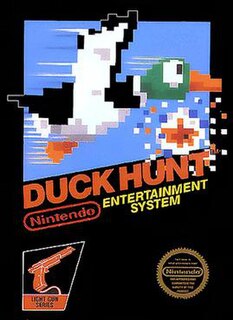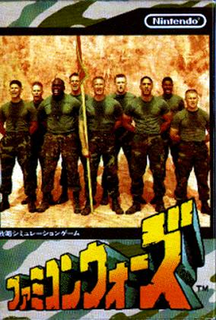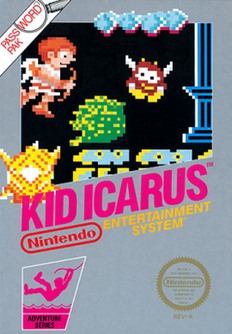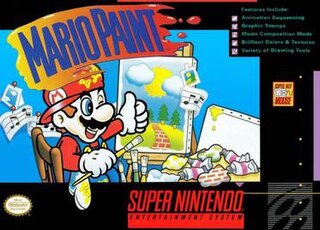 W
WBalloon Fight is an action video game developed by Nintendo. The original arcade version was released for the Nintendo VS. System as Vs. Balloon Fight, and its Nintendo Entertainment System counterpart was internationally released in 1986. The gameplay is similar to the 1982 game Joust from Williams Electronics. The home Nintendo Entertainment System version was ported to the NEC PC-8801 in October 1985, the Sharp X1 in November 1985, the Game Boy Advance as Balloon Fight-e for the e-Reader in the United States on September 16, 2002, and as part of the Famicom Mini Series in Japan on May 21, 2004. It was later rereleased through Nintendo's Virtual Console and NES Classic Edition and is currently available to play on Nintendo Switch Online.
 W
WBalloon Kid is a flying platform game developed by Pax Softnica and published by Nintendo for the Game Boy on October 5, 1990 in North America and on January 31, 1991 in Europe. It is the sequel to Balloon Fight. It was never released in Japan for the original Game Boy; however, two years after its original release, a licensed Family Computer port titled Hello Kitty World was reprogrammed and released by Sanrio's subsidiary Character Soft exclusively in Japan on March 27, 1992. A Game Boy Color edition with a few new features titled Balloon Fight GB was released in Japan on July 31, 2000.
Barker Bill's Trick Shooting is a light gun shooting game released in North America for the NES by Nintendo in 1990, based on the 1950s television series Barker Bill's Cartoon Show.
 W
WBaseball is a 1983 video game from Nintendo. Being a launch game for the Nintendo Entertainment System, and the universal appeal of its namesake sport, are said to have made Baseball a key to the system's overall success, and an important piece of Nintendo history.
 W
WDonkey Kong 3 is the third video game in the original Donkey Kong series by Nintendo. It was released in arcades in 1983 and the Family Computer in 1984, then later released in America for the Nintendo Entertainment System in 1986. The gameplay departs from previous Donkey Kong games, being primarily a shooter, and starring an exterminator named Stanley instead of Mario.
 W
WDr. Mario is a 1990 action puzzle video game produced by Gunpei Yokoi and designed by Takahiro Harada. Nintendo developed and published the game for the Nintendo Entertainment System and Game Boy consoles. The game's soundtrack was composed by Hirokazu Tanaka.
 W
WDuck Hunt is a 1984 light gun shooter video game developed and published by Nintendo for the Nintendo Entertainment System (NES) video game console. The game was first released in Japan in April 1984 and was released as a launch game for the NES in North America in October 1985, with it also releasing in Europe two years later.
 W
WEarthBound is a role-playing video game developed by Ape Inc. and HAL Laboratory and published by Nintendo for the Super Nintendo Entertainment System. The second entry in the Mother series, it was first released in Japan in August 1994, and in North America in June 1995. As Ness and his party of four, Paula, Jeff and Poo, the player travels the world to collect melodies from eight Sanctuaries in order to defeat the universal cosmic destroyer Giygas, also known as Giegue or Gyiyg.
 W
WFamicom Wars is a wargame produced by Nintendo. It was released on August 12, 1988 for the Family Computer in Japan. It was later re-released on Virtual Console. It is the first game in the Wars series.
 W
WGolf is a sports-simulation video game developed and released by Nintendo in 1984 for the Famicom in Japan, in 1985 for the NES in North America, and on Family Computer Disk System in 1986 again in Japan. The golfer has been identified as Mario in supplemental materials, though not wearing his traditional shirt and overalls. However, the game Captain Rainbow would instead identify the golfer as Ossan, which happens to be one of the generic internal names Mario had during the development of Donkey Kong. Additionally, the Game Boy conversion of this game would feature Mario on the Western cover art, but not the Japanese version.
 W
WGumshoe is a video game developed and published by Nintendo for the NES and released in 1986 in North America and in 1988 in Europe. Gumshoe is played using the NES Zapper. The game was designed by Yoshio Sakamoto.
 W
WHeli Fire is an video game developed by Nintendo, and released in arcades in September 1980 by Nintendo. Some sources claim that Ikegami Tsushinki also did design work on Heli Fire. Similar to the 1980 Taito title Polaris, players control a submarine in which they must survive as long as possible against a barrage of enemy attacks from the sea and above.
 W
WHogan's Alley is a 1984 video game by Nintendo. It was one of the first games to use a light gun as an input device. The game presents players with "cardboard cut-outs" of gangsters and innocent civilians. The player must shoot the gangs and spare the innocent people.
 W
WKid Icarus, known in Japan as A Mythology of Light: The Mirror of Palthena, is an action platform video game for the Family Computer Disk System in Japan and the Nintendo Entertainment System in Europe and North America. It was released in Japan in December 1986, in Europe in February 1987, and in North America in July 1987.
 W
WMario Paint is a video game released in 1992 by Nintendo for use with the Super Nintendo Entertainment System. It is packaged with the Super NES Mouse peripheral. The game was developed by Nintendo Research & Development 1 and Intelligent Systems.
 W
WMetroid is an action-adventure game developed and published by Nintendo. The first installment in the Metroid series, it was originally released in Japan for the Family Computer Disk System peripheral in August 1986. North America received a release in August 1987 on the Nintendo Entertainment System in the Game Pak ROM cartridge format, with the European release following in January 1988. Set on the planet Zebes, the story follows Samus Aran as she attempts to retrieve the parasitic Metroid organisms that were stolen by Space Pirates, who plan to replicate the Metroids by exposing them to beta rays and then use them as biological weapons to destroy Samus and all who oppose them.
 W
WMother, officially known outside of Japan as EarthBound Beginnings, is a role-playing video game developed by Ape and published by Nintendo for the Famicom. The first entry in the Mother series, it was first released in Japan on July 27, 1989. It is modeled on the gameplay of the Dragon Quest series, but is set in the late 20th-century United States, unlike its fantasy genre contemporaries. Mother follows the young Ninten as he uses his great-grandfather's studies on psychic powers to fight hostile, formerly inanimate objects and other enemies. The game uses random encounters to enter a menu-based, first-person perspective battle system.
 W
WRadar Scope is a 1980 fixed shooter arcade game developed by Nintendo R&D 2 and published by Nintendo. The player assumes the role of the Sonic Spaceport starship and must wipe out formations of an enemy race known as the Gamma Raiders before they destroy the player's space station. Gameplay is similar to Space Invaders and Galaxian, but set in a forced perspective angle.
 W
WSnoopy Concert (スヌーピーコンサート) is a Japan-exclusive action video game based on the Peanuts cartoon characters Snoopy licensed from Peanuts and United Feature Syndicate, which was released for the Super Famicom in 1995 as the first Peanuts game to be exclusive to that country. Some English-patched ROM images has been released on the internet.
 W
WSpace Firebird is a 1980 arcade game developed by Nintendo R&D1.
 W
WSuper Mario Land is a 1989 side-scrolling platform video game developed and published by Nintendo as a launch title for their Game Boy handheld game console. It is the first Mario platform game ever to be released for a handheld console. In gameplay similar to that of the 1985 Super Mario Bros., but resized for the smaller device's screen, the player advances Mario to the end of 12 levels by moving to the right and jumping across platforms to avoid enemies and pitfalls. Unlike other Mario games, Super Mario Land is set in Sarasaland, a new environment depicted in line art, and Mario pursues Princess Daisy. The game also includes two Gradius-style shooter levels.
 W
WTetris is a puzzle video game for the Game Boy released in 1989. It is a portable version of Alexey Pajitnov's original Tetris and it was bundled in the North American and European releases of the Game Boy itself. It is the first game to have been compatible with the Game Link Cable, a pack-in accessory that allows two Game Boys to link together for multiplayer purposes. A colorized remake of the game was released on the Game Boy Color entitled Tetris DX . A Nintendo 3DS Virtual Console version of Tetris was released in December 2011 and it lacked the multiplayer functionality. It was delisted from the Nintendo eShop after December 31, 2014.
 W
WTetris is a puzzle video game for the Nintendo Entertainment System released in 1989. It was the first official console release of Tetris which was developed and published by Nintendo.
 W
WUrban Champion (アーバンチャンピオン) is a 2-player fighting game produced by Nintendo in 1984. It was inspired by the 1984 Game & Watch title Boxing. It is also Nintendo's first 2D fighting game, eventually followed in 1993 by Joy Mech Fight, released exclusively in Japan for the same platform.
 W
WWrecking Crew is a 1985 action game developed and published by Nintendo. It was designed by Yoshio Sakamoto and released as a launch title for the Nintendo Entertainment System.
 W
WYakuman (役満) is a 1989 mahjong video game developed by Intelligent Systems and published by Nintendo for its handheld Game Boy as one of the Japanese launch titles. It is the first entry in a series of first-party Japanese mahjong games on Nintendo systems, with sequels on the Famicom, Game Boy Advance, DS, Wii, Wii U, and 3DS.